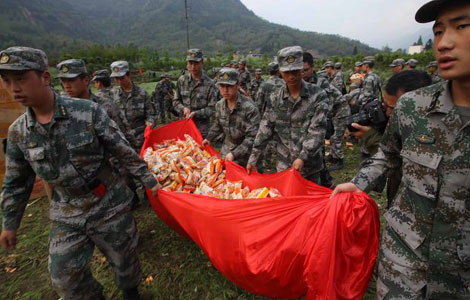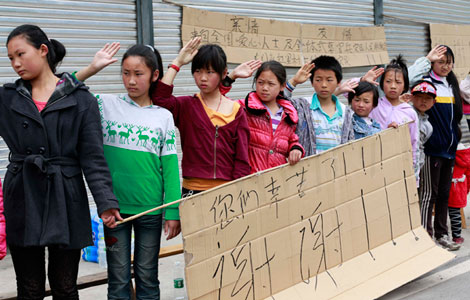Acid rain hangs cloud over Guangdong province
Updated: 2012-08-27 07:31
By Li Wenfang in Guangzhou (China Daily)
|
||||||||
More of Guangdong province came under threat of severe damage from acid rain in the first half of this year, a result in part of an increase in automobile emissions, a recent environment report showed.
Five cities and districts in the province - Shaoguan, Qingyuan, Foshan, Shenzhen and Shunde - were found to be heavily polluted by acid rain in the first six months of this year, up from four in the same period of last year, according to a provincial environmental report for the first half of 2012.
The report, released by the provincial environmental protection department last week, found that 12 cities, or more than half of the province's 21 cities, were polluted by acid rain in the first half, up from 11 in the same period of 2011.
Environmental experts said most acid rain in Guangdong results from the high concentration of nitrogen oxide and sulfur dioxide in the air in the province.
The report said nitrogen oxide has become a major cause of acid rain in the past six months, a result partly of the greater number of automobiles on the province's roads and an inability to adequately control their emissions.
The concentration of sulfur dioxide in the province's air has dropped by 20 percent year-on-year, but various conditions are still leading to a higher production of acid rain, said Zhou Yongzhang, director of the Center for Earth Environment and Resources at the Sun Yat-sen University in Guangzhou.
Zhou said a few cities in Guangdong have been burning more coal to produce power, thus compensating for a decline in power transmission from western China.
Experts also believe that the persistence of acid rain in Shaoguan and Qingyuan, the top two cities on the list, results from the various dirty industries, such as the cement and ceramics industries, that have moved to those two cities from developed areas in the Pearl River Delta.
Guangdong province, the manufacturing center of China, was heavily polluted by acid rain a few years ago. As a popular saying then had it: "Eight out of nine cities in Guangdong are raining acid".
Much work has been done in recent years to clean up the air, and general conditions have improved. But more still should be done, experts said.
Zhou called for greater attention to be paid to reducing emissions of nitrogen oxides, especially since regulations are already in place to control the sulfur dioxide released by coal-burning power plants.
Experts also said cities should set a long-term goal of preventing such acid rain from persisting.
Despite the worsening pollution, the environmental report found that Guangdong's air quality improved in the first half of the year.
The concentration of nitrogen dioxide in the air decreased by 7.4 percent during the period and that of inhalable particles by 17.5 percent, according to the report.
At the same time, the report did not consider readings for ozone and concentrations of PM2.5 - particulate matter smaller than 2.5 micrometers in diameter.
Water pollution remains a concern, as monitoring data showed that five sections of the province's rivers are heavily polluted. Those make up 8.1 percent of the total length of all rivers in Guangdong.
Three of those five sections are in Shenzhen, one in Zhanjiang and one in eastern Guangdong, according to the report.
Nanfang Daily, citing the provincial environmental protection department, said the lingering heavy pollution in parts of the rivers is the result of industries that employ lots of labor, enterprises that release various harmful substances and sewage treatment that is insufficient.
Lianjiang River in eastern Guangdong, for example, has been contaminated by the printing and dyeing industries, among others.
Fortunately, the 69 drinking water sources for the 21 cities and the Shunde district all met national standards for water quality during the period, it added.
The province's plans to clean up local waterways between 2012 and 2020 will soon be submitted to the provincial government for approval, according to media reports.
Shu Meng contributed to this story.
liwenfang@chinadaily.com.cn

 Relief reaches isolated village
Relief reaches isolated village
 Rainfall poses new threats to quake-hit region
Rainfall poses new threats to quake-hit region
 Funerals begin for Boston bombing victims
Funerals begin for Boston bombing victims
 Quake takeaway from China's Air Force
Quake takeaway from China's Air Force
 Obama celebrates young inventors at science fair
Obama celebrates young inventors at science fair
 Earth Day marked around the world
Earth Day marked around the world
 Volunteer team helping students find sense of normalcy
Volunteer team helping students find sense of normalcy
 Ethnic groups quick to join rescue efforts
Ethnic groups quick to join rescue efforts
Most Viewed
Editor's Picks

|

|

|

|

|

|
Today's Top News
Health new priority for quake zone
Xi meets US top military officer
Japan's boats driven out of Diaoyu
China mulls online shopping legislation
Bird flu death toll rises to 22
Putin appoints new ambassador to China
Japanese ships blocked from Diaoyu Islands
Inspired by Guan, more Chinese pick up golf
US Weekly

|

|







